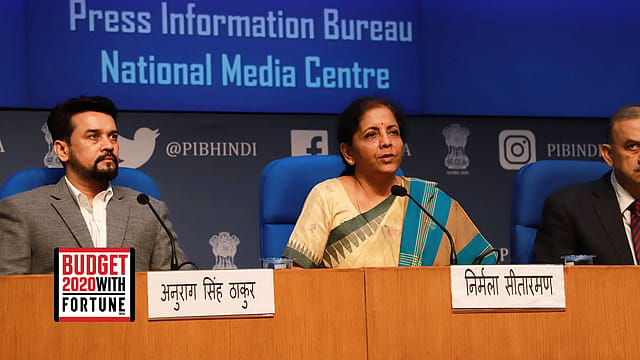Wanted: A forward-looking Budget
ADVERTISEMENT

As the government gears up to present its first budget after re-election, there are many demands India Inc. has – more so given the slowdown of the economy. With primary drivers such as investment and government spending on a weak footing, it will be a litmus test on all fronts. Apart from revenue generation, it remains to be seen how the government will ensure that this income is distributed fairly across the consumer pyramid. From tax cuts, spurring demand, and addressing healthcare spending, here are my thoughts on what to expect from the budget this year.
ESOP (employee stock ownership plan) taxation
ESOPs must be taxed at the point of liquidity and not exercise. In the current system, this is an impossible scenario for employees. Given that they must pay a huge tax amount despite not owning any money, it is imperative that employees get the benefit of vested options. In most cases, the true benefit of ESOPs is not realised as the options become worthless in case the valuation goes down. To motivate and nudge professionals to join startups and undergo the grind, there is a need for changes in taxation – and ESOPs are an important tool in ensuring this.
Dedicated grants and funds
India has the potential of becoming a global player in many emerging sectors provided the government considers allocation of funds to catalyse initiatives. Startups in these domains have the potential to solve some of the most pertinent problems facing the country. To enable them, adequate grants and funds must be earmarked for research and development. Apart from this, there is a need to create centers of excellence, and come up with innovative solutions that allow talent to mushroom.
December 2025
The annual Fortune 500 India list, the definitive compendium of corporate performance, is out. This year, the cumulative revenue of the Fortune 500 India companies has breached $2 trillion for the first time. Plus, find out which are the Best B-schools in India.
Currently, early-stage startups working in the fields of deep tech, agri-tech, renewable energy, sustainability, etc. do not attract private sector venture funds and may take anywhere between 10 and 20 years to make an impact. Dedicated focus and funding from the government will help them become commercially and economically viable for the private sector to step in. To give a fillip to capital flowing into these underserved sectors, the government should look at providing incentives, tax breaks and allow CSR funds to be used for R&D in select areas.
Changes must also be made within the country’s regulatory environment to drive greater innovation in the startup sector. The innovative capabilities of Indian startups can be gauged by the fact that between 2015 and 2018, they filed nearly 200 patents in the U.S. There is thus an urgent need for a comprehensive Intellectual Property Rights (IPR) framework and effective implementation of Intellectual Property (IP)-friendly policies. This will make obtaining a patent less complex and expensive and time-consuming.
Tax parity listed and unlisted equity sale
A provision that can become a game-changer in this year’s budget is sale of unlisted equities being taxed at the same rates as listed ones. It will encourage investments into startups or unlisted equities and lead to creation of more jobs. The move will also help foster innovation and lead to newer business models.
Tax exemption incentive
We hope to see tax exemption for amounts invested in accredited startups to address the rate of ‘infant mortality’ in these entities and encourage angel investments, risk-taking, and creation of more jobs. When there is monetisation or capital gain during a successful exit, the same can be taxed. The key focus must be on drawing more money into startups at the early stage which can be done by encouraging investors through positive incentives.
Carry forward tax losses
Even in cases where there is a change in shareholding, it is imperative to allow startups to carry forward losses incurred. One of the ways that startups survive, pivot, and make their business model work is through mergers and acquisitions and consolidation. Carrying forward tax losses is important for this to work and make the restructuring attractive.
Simplification of filings and compliance
In their early years, startups tend to spend a lot of time and effort (not to mention, cost) in filing GST, tax returns, and TDS information – all of which can be overwhelming. To ease out this burden, the government must consider allowing accredited startups to file these returns on a quarterly instead of monthly basis for the first two years.
Healthcare
India’s healthcare spending continues to stand at 1% as against the 2.5% of GDP promised by the government (by 2025). The last budget had absolutely no mention of healthcare and we hope to see some action on this front urgently. There is currently a mismatch in the ratio of hospital beds to patients, and home healthcare can address this concern, apart from many others. The need of the hour is to thus recognize home healthcare as a mainstream sector, bringing it under the ambit of governmental schemes. Within home healthcare, the focus must be given to eldercare given that their population is set to increase in the years ahead. We also look forward to an increase in the tax exemption ceilings under Section 80D towards the cost of preventive check-ups. This will encourage more people to undertake preventive health screening and reduce spending on treatment.
India is a growing economy and one of the largest startup ecosystems in the world. For long-term growth prospects, it is imperative that the budget brings forth a stable policy regime that is forward-looking and fosters a healthy competitive environment. Better job prospects, skilling the young workforce and better access to quality healthcare are the three important drivers of economic growth in the present scenario --- the budget must become an enabler.
Views are personal.
The author is a serial entrepreneur and partner at GrowthStory
